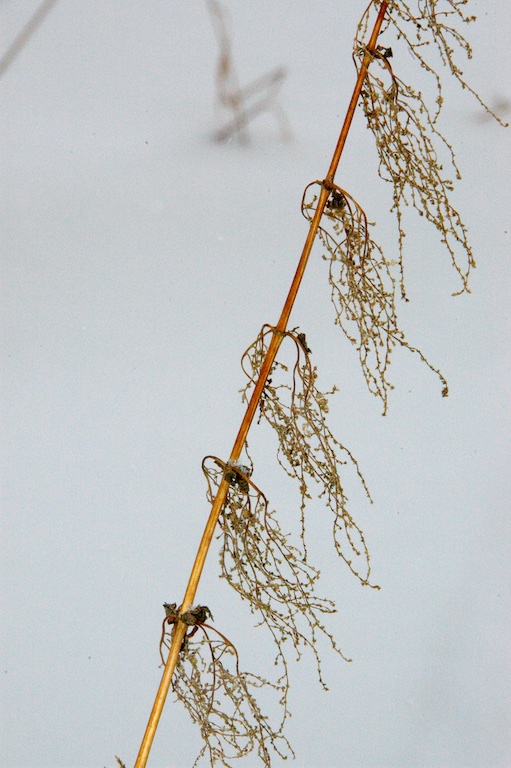
Even in a good year we have too much winter. Can we please swap February for an extra month of October?

Golden willow is always a winter hit.

Choose trees and shape them for the way they hold snow in winter. This is an unknown crab apple that came with our house.

Dogwood in winter shows it's dark red bark.

Sign of Spring: Pussy willows can bloom any time from February to April. All it takes is a few days of warm weather. You can also cut twigs and force them indoors.



Yes, indeed, too much winter. This isn't my picture, but one I used as part of a video on a cold winter day. If you need a chuckle, check This out.
Trees and Shrubs for Winter Interest
Because we have so much winter

Sometimes we have to make do with small details. Here, the cones of Alder trees. These cones are seed shakers all winter. The tiny alder seeds, about the size of pepper specs, feed chickadees all winter long.

Wild roses. Rose hip in November. We had a week of grey skies, and freezing fog. I caught this on a sunny afternoon when it got above freezing for a few minutes.

I'm cheating a bit. I knew that this dead leaf would look cool if I caught it just at sunset with the light slanting through the forest.

Not all birches are white. This one has a salmon flavour to it. Or at least colour.

Even the lowly nettle looks interesting in winter. No stings now. That ends with the first hard frost.

Definitely: Too much winter. I hate snowblowing. Always some down your neck. Always a stiff neck driving backward.
We have so much winter. For 6 months of the year, we have a landscape of snow (sometimes tinted with various amounts of dirt and tree crumbs. The rest of the world has a subdued pallet of grey-brown bark, spruce that in the distance look almost black, and up close often have a yellowish tinge. Please, give me anything interesting to look at.
Better, I will trade you February, for a second copy of October.
No flowers or leaves in winter, but we do have bark and needles, and buds. Here's a few ideas:
Dogwood Twigs are reddish even in summer, but in autumn the chlorophyll in the twigs bleaches out, leave a dark scarlet. Takes until November to get to their prime. Cut a bunch of twigs for an interior winter bouquet. Prune at the end of winter. This allows you to enjoy them all winter, and encourages the dogwood to put out a bunch of new twigs.
Golden Willow This year's growth goes schoolbus yellow, with orange tips. Last year's growth is a lighter yellow. Older than that is bark colour. Prune really hard every 3 years. This willow will turn into a tree if you let it.
Flame Willow Bark is orange and yellow in streaks depending, I think, on sun exposure. This guy only gets about 15 feet high.
Wild rose Burgundy stems and very red fruit.
Manitoba Maple and Green Ash Tan seed cluster wait until spring to come off. Some of the other maples also hold their seeds.
Lilac Dark brown seed capsules.
Snowberry The tissue between the leaf veins dries and falls away, leaving the leaf with a delicate tracery of veins.
High Bush Cranberry Winter buds are magenta.
Pussy Willow All winter: milk chocolate coloured twigs. Late winter: Branches are strewn with fuzzy catkins. If you cut a bunch of twigs in February, and set them in water, you can trick them into doing their show early.
Birches Bark ranging in colour from white to grey to sometimes pale salmon. Bark peels in interesting patterns. Twigs and young branches are dark chocolate.
Amur Cherry Bark is a copper-gold colour with some peeling.
Ninebark Older branches have streaked shredded looking bark with light and dark stripes.
Got something to say? Email me: sfinfo@sherwoods-forests.com
Interesting? Share this page.
Want to talk right now? Call me: (8 am to 8 pm only, please) 1-780-848-2548
Do not arrive unannounced. Phone for an appointment. Why? See Contact & Hours That same page gives our hours of operation.
Back to Top
Copyright © 2008 - 2021 S. G. Botsford
Sherwood's Forests is located about 75 km southwest of Edmonton, Alberta. Please refer to the map on our Contact page for directions.
